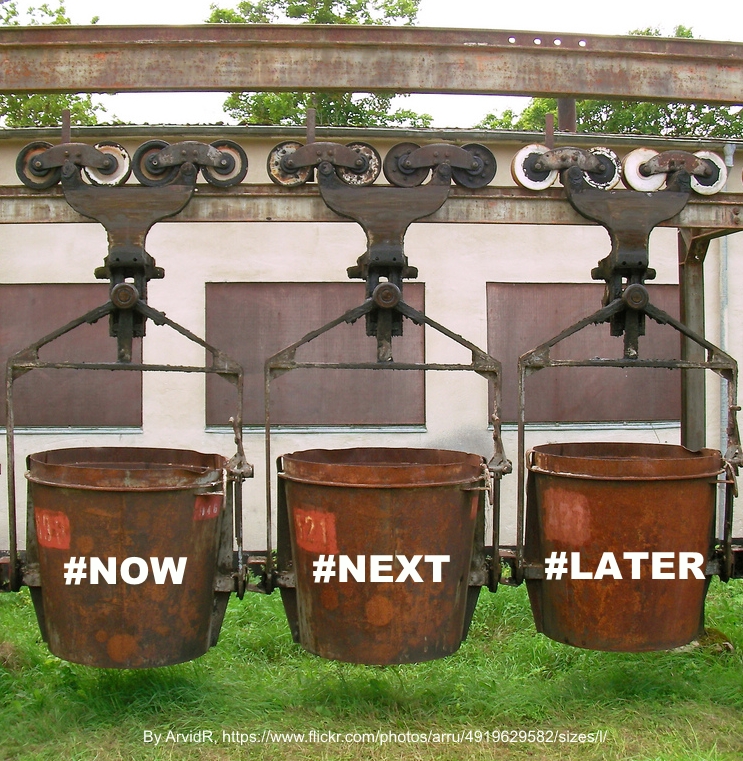Simple Planning Model for Small Businesses
A while ago I came across an article written by Noah Weiss for Medium.com (Nov. 2014), which describes a simple planning model he calls #now, #next, #later. In it he discusses a method for smaller businesses and teams to create effective action plans using what he calls “Priority Buckets”.

As I read on, I realized this might work really well within the systems thinking planning model. You still need to have a direction, a Desired State or Vision of what you want to achieve. But once you’ve identified that, it would be fairly simple to then ask yourself the following three questions:
If XXXXX is what we want to achieve or what we want our organization to BE in 12-18 months, then…
1) What do we need to do #now to make sure this happens?
Now is within the next 2-4 weeks. These are the most critical actions that will make the biggest difference in the shortest amount of time. They are usually easy to identify, and many may already be underway. Once those are identified, then ask…
2) What do we need to do #next to achieve this Desired State or Vision?
These are the actions or activities that must be accomplished in the next 1-3 months AFTER the #now activities.
These are harder to identify, so sometimes a simple exercise of “If this, then that”, may be necessary here. Developed by a colleague and project management pro, Terry Schmidt, this consists of asking “If this is to occur, then what needs to happen to make it so?” Keep asking that as you identify each of the steps or activities needed to achieve a specific goal.
For example, if your team is trying to determine which of two software investments to make, you might ask….
A. If we make investment #1, then what else will need to happen? These could be
> additional IT resources will be needed for new programming, for example, and
> we’ll need to create new training programs for the staff who will use the new tool.
The initial investment may be the least out of pocket cost, but what are the internal costs of additional resources being diverted for extra programming and training? How many months will it take to get approval for the resources, do the internal programming, and create and deploy the training modules?
B. If we make investment #2, then what else will need to happen? These might be
> no additional IT programming since the tool exists in the cloud, not on the company servers.
> no need to create training programs since the investment comes with pre-recorded training videos.
This out-of-pocket investment may be more, but it will enable the company to hit the ground running and be up to speed faster without diverting additional resources for programming and training.
3) What do we need to do #later?
This is the final question to ask and concerns the activities that may take place 3+ months AFTER the #now and #next activities. Essentially, this is a place to park the ideas that various members have a passion for, but which aren’t necessarily critical to achieving the Desired State or Vision. Just list them here and re-visit them again in three months to see if anything has changed.
By asking these questions, your team has essentially created a simple action plan that includes your Desired State or Vision with a date by when that’s to be accomplished, and then the critical actions that need to take place to achieve it. Each action needs to have dates by when they must be achieved and a leader to move that action forward. You will also need to identify the minimum acceptable goal for each activity.
For example, if purchasing the software in the above example is the decision, and you don’t have all the funds in place, then you need to identify the minimum dollar amount you need to raise within the next 3 months in order to purchase the software. Remember, the purchase of that software is one of the critical activities that will help you achieve your Desired State in the next 12-16 months.
You also need to identify the specific activities you need to undertake to raise that minimum dollar amount to purchase the software, who will lead each fund raising activity, and by when each will be accomplished. Then gather together again as a team within the next 3 months to review your results, make any changes, and adjust your #now, #next, #later activities.
Each team member can then tag their own actions as fitting under #now, #next, #later to help them prioritize the detailed activities they are working on under each of the larger action items.
It’s easy to get mired in the details the further you go down this path. It’s somewhat like following Dorothy down a rabbit hole and getting lost in the woods. So it frequently helps to have a facilitator in the room to keep you on track and help you find your way to the “yellow brick road”.
Contact us if you have questions about this and/or would like help implementing this at your organization.

